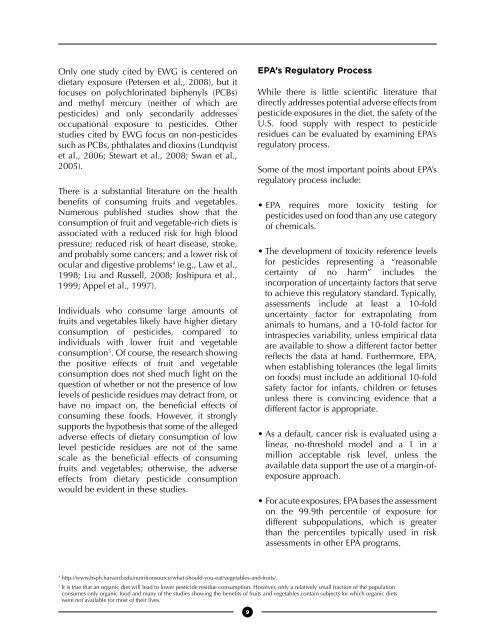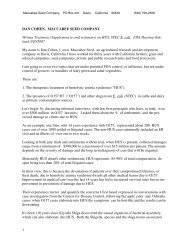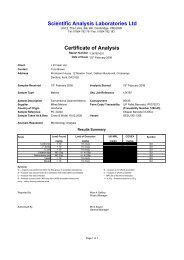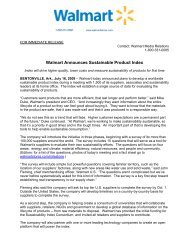here - Perishable Pundit
here - Perishable Pundit
here - Perishable Pundit
You also want an ePaper? Increase the reach of your titles
YUMPU automatically turns print PDFs into web optimized ePapers that Google loves.
Only one study cited by EWG is centered ondietary exposure (Petersen et al., 2008), but itfocuses on polychlorinated biphenyls (PCBs)and methyl mercury (neither of which arepesticides) and only secondarily addressesoccupational exposure to pesticides. Otherstudies cited by EWG focus on non-pesticidessuch as PCBs, phthalates and dioxins (Lundqvistet al., 2006; Stewart et al., 2008; Swan et al.,2005).T<strong>here</strong> is a substantial literature on the healthbenefits of consuming fruits and vegetables.Numerous published studies show that theconsumption of fruit and vegetable-rich diets isassociated with a reduced risk for high bloodpressure; reduced risk of heart disease, stroke,and probably some cancers; and a lower risk ofocular and digestive problems 4 (e.g., Law et al.,1998; Liu and Russell, 2008; Joshipura et al.,1999; Appel et al., 1997).Individuals who consume large amounts offruits and vegetables likely have higher dietaryconsumption of pesticides, compared toindividuals with lower fruit and vegetableconsumption 5 . Of course, the research showingthe positive effects of fruit and vegetableconsumption does not shed much light on thequestion of whether or not the presence of lowlevels of pesticide residues may detract from, orhave no impact on, the beneficial effects ofconsuming these foods. However, it stronglysupports the hypothesis that some of the allegedadverse effects of dietary consumption of lowlevel pesticide residues are not of the samescale as the beneficial effects of consumingfruits and vegetables; otherwise, the adverseeffects from dietary pesticide consumptionwould be evident in these studies.EPA’s Regulatory ProcessWhile t<strong>here</strong> is little scientific literature thatdirectly addresses potential adverse effects frompesticide exposures in the diet, the safety of theU.S. food supply with respect to pesticideresidues can be evaluated by examining EPA’sregulatory process.Some of the most important points about EPA’sregulatory process include:• EPA requires more toxicity testing forpesticides used on food than any use categoryof chemicals.• The development of toxicity reference levelsfor pesticides representing a “reasonablecertainty of no harm” includes theincorporation of uncertainty factors that serveto achieve this regulatory standard. Typically,assessments include at least a 10-folduncertainty factor for extrapolating fromanimals to humans, and a 10-fold factor forintraspecies variability, unless empirical dataare available to show a different factor betterreflects the data at hand. Furthermore, EPA,when establishing tolerances (the legal limitson foods) must include an additional 10-foldsafety factor for infants, children or fetusesunless t<strong>here</strong> is convincing evidence that adifferent factor is appropriate.• As a default, cancer risk is evaluated using alinear, no-threshold model and a 1 in amillion acceptable risk level, unless theavailable data support the use of a margin-ofexposureapproach.• For acute exposures, EPA bases the assessmenton the 99.9th percentile of exposure fordifferent subpopulations, which is greaterthan the percentiles typically used in riskassessments in other EPA programs.4http://www.hsph.harvard.edu/nutritionsource/what-should-you-eat/vegetables-and-fruits/.5It is true that an organic diet will lead to lower pesticide residue consumption. However, only a relatively small fraction of the populationconsumes only organic food and many of the studies showing the benefits of fruits and vegetables contain subjects for which organic dietswere not available for most of their lives.9








